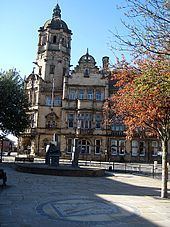Country Germany Admin. region Münster Time zone CET/CEST (UTC+1/+2) Elevation 98 m Population 75,408 (31 Dec 2010) Administrative region Münster | Postal codes 44575–44581 Area 51.66 km² Local time Monday 1:16 PM | |
 | ||
Weather 7°C, Wind SW at 8 km/h, 80% Humidity | ||
Castrop-Rauxel ( [ˈkastʁɔpˈʁaʊksəl]) is a former mining city in the eastern part of the Ruhr Area in Germany.
Contents
- Map of Castrop Rauxel Germany
- Geography
- Urban Area
- History
- Mayors
- Transport
- International relations
- Economy
- Culture
- Notable people
- References
Map of Castrop-Rauxel, Germany
Geography
Castrop-Rauxel is between Dortmund to the east, Bochum (south), Herne (west), and to the north, Recklinghausen, Datteln and Waltrop.
Urban Area
The urban area of Castrop-Rauxel has a total expanse of 51.66 km2 (19.95 sq mi). The Halde Schwerin is marked as the highest point of the city with 147 m over NN, the lowest point is the Pöppinghauser street beside house number 264 with 50.2 m over NN.
The city is divided into 15 districts, listed in order from north to south: Becklem, Henrichenburg, Ickern, Habinghorst, Pöppinghausen, Deininghausen, Rauxel, Bladenhorst, Behringhausen, Castrop, Dingen, Schwerin, Obercastrop, Frohlinde and Merklinde.
The total area of the city divided into different uses (31.12.2010):
Population figures for the individual districts (Stand: 2005):
History
First mentioned in 834 as "Villa Castorpe", the city of Castrop was founded in 1902 by merging the municipalities Castrop, Obercastrop and Behringhausen. On April 1, 1926 Castrop-Rauxel was formed when Castrop merged with 10 other municipalities. During World War II, a plant at Castrop-Rauxel used the Bergius process to produce synthetic (German: Ersatz) oil products.
In 1975, the village of Henrichenburg was annexed and Castrop-Rauxel became part of the Recklinghausen (district). In 1984 the last of 7 coal mines at Castrop-Rauxel ("Erin") closed.
Mayors
Lord Mayors
Mayors
Transport
Castrop-Rauxel has access to three major highways, the Emscherschnellweg A 42,the Sauerlandlinie A 45 and the A 2.
There are 3 railway stations within the city. The central station (Castrop-Rauxel Hauptbahnhof) on the Cologne-Minden Railway is located in the suburb of Rauxel. Connecting Castrop-Rauxel to the western Ruhr cities like Duisburg, Oberhausen, Essen, Gelsenkirchen, Herne and in the east to Dortmund and Hamm. The unmanned stations of Castrop-Rauxel South (Castrop-Rauxel Süd) and Castrop-Rauxel Merklinde on the Duisburg-Ruhrort–Dortmund railway have hourly services with trains to Dortmund, Herne and Dorsten. Located in the city centre is the central bus station Muensterplatz. From here passengers can travel to almost all suburbs and to neighboring cities like Herne, Dortmund and Bochum.
The Rhine-Herne Canal runs right through Castrop-Rauxel; Castrop-Rauxel also has a small Yacht club on this body of water.
International relations
Castrop-Rauxel is twinned with:
Economy
Castrop-Rauxel has been attempting to change from a former mining city to a city with a modern lifestyle, high recreational value, new economy companies, a 27-hole golf course, and various cultural events.
Metalworking and electronics are the key manufacturing sectors.
Culture
The WLT (Westphalian State Theater) is the oldest and most relevant source of theatrical entertainment in Castrop-Rauxel. There is one cinema with two screens in Castrop. Castrop’s history is closely connected to horse racing, the Reiterbrunnen in the very center of Castrop’s market square is a reminder of the race days on the Naturhindernisbahn, now part of the Goldschmieding Park.
